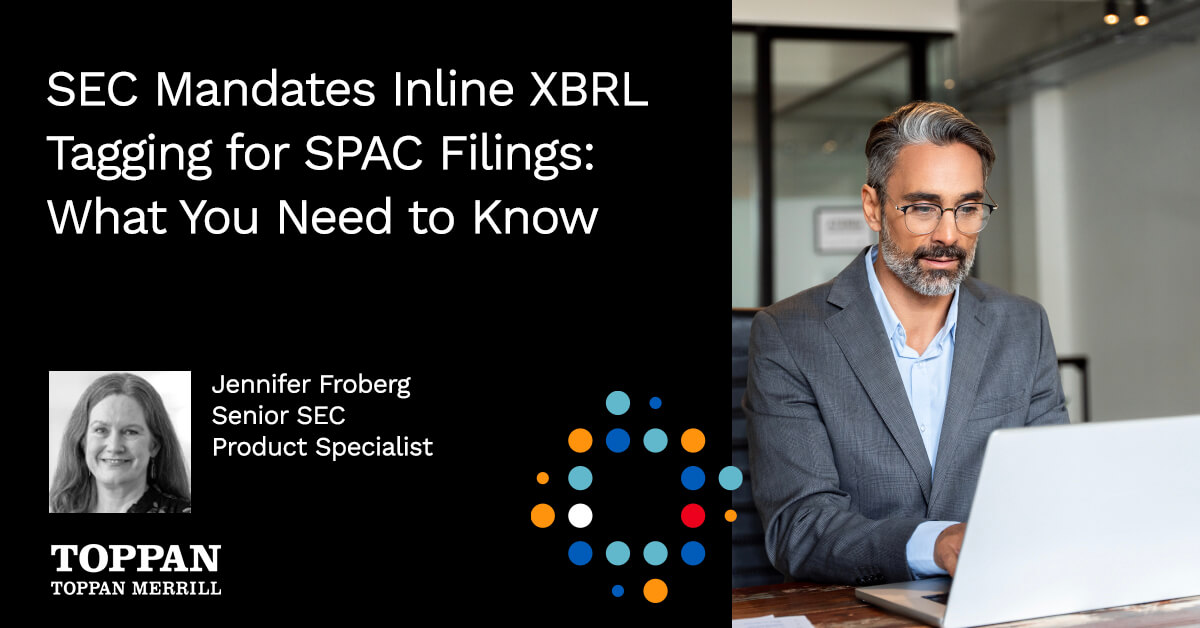Summary
Effective January 1, 2023, Variable Product issuers of actively sold contracts are required to file registration statements and definitive updates using Inline XBRL (iXBRL).
Background
For decades the SEC has sought to harness technology to provide a mechanism for allowing investors, Commission staff, data aggregators, financial analysts and other data users to efficiently analyze and compare the available information about variable contracts, as required by their particular needs and circumstances.
On March 11, 2020, the SEC adopted the new rule, Updated Disclosure Requirements and Summary Prospectus for Variable Annuity and Variable Life Insurance Contracts, more commonly referred to as Rule 498A. The rule mandates, beginning January 1, 2023, Variable Product issuers of actively sold contracts are required to file registration statements and definitive updates using Inline XBRL (iXBRL).
Like Mutual Funds, ETFs, Business Development Companies and Closed End Funds, Variable Product issuers will be required to submit to the Commission in iXBRL the certain information contained below in their pre-effective registration statements or post-effective amendments filed on Forms N-3, N-4, and N-6, and forms of prospectuses filed pursuant to Rule 497(c) or Rule 497(e) under the Securities Act that include information that varies from the registration statement. The iXBRL filing format, which brings together both the human-readable and machine-readable formats, is the mandated standard required for operating companies.
The new iXBRL requirement has triggered a myriad of questions from issuers impacted by the rule, including:
- What documents and filings need to be tagged?
- What content within the document needs to be tagged?
- Which products will be required to file in iXBRL format?
- Can any products continue to file in traditional XBRL?
- When and how do we create the iXBRL filing package?
- Are there any changes to the form types?
- How will this impact my document preparation workflow?
- What will be the impact on my review cycles?
- What does this do to my production cycle?
- Are tools available to help simplify the process?
- Who can help me understand XBRL and iXBRL more clearly?
- How is XBRL being consumed and used?
What do Variable Product Issuers need to do to be in compliance?
The SEC approved Inline XBRL requirements for Variable Contracts as originally proposed, however due to comments received, the final adopted rule only applies to contracts being sold to new investors.
- The SEC believes that the items, shown in the table below, provide important information about a variable contract’s key features, costs and risks, are most suited to being tagged in a structured format and will be of greatest utility for investors and other data users that seek structured data to analyze and compare variable contracts.
- The SEC is requiring that registrants tag the following statutory prospectus disclosure items using Inline XBRL: the Key Information Table; Fee Table; Principal Risks of Investing in the Contract; Standard Death Benefits (Form N-6 filers); Other Benefits Available Under the Contract; Portfolio Companies [Investment Options] Available Under the Contract.
Item No. Form N-4 Form N-6 Section 2 Key Information Key Information 6 4 Fee Table Fee Table 7 5 Principal Risks Principal Risks 8 10 Benefits Available Standard Death Benefits 11 Not applicable Other Benefits Available 17 Portfolio Companies Not applicable 10 18 Not applicable Portfolio Companies 10
- For Registration statements with multiple contracts, tagging will be required for contracts that are still being sold to new investors but will not be required for contracts that are not being sold to new investors even if those contracts are still accepting purchase payments or premiums from existing investors.
For contracts being sold to new investors in a framework similar to that for mutual funds and ETFs, variable contract registrants are required to submit in iXBRL format as follows:
- Post-effective amendments filed pursuant to paragraph (b)(1)(i), (ii), (v), or (vii) of Rule 485, and in the case of registrants on Forms N-4 or N-6, paragraph (b)(1)(vi) of Rule 485, Interactive Data Files must be filed either concurrently with the filing or in a subsequent amendment that is filed on or before the date that the post-effective amendment that contains the related information becomes effective;
- Initial registration statements and post-effective amendments filed other than pursuant to paragraph (b)(1)(i), (ii), (v), or (vii) of Rule 485, and in the case of registrants on Forms N-4 or N-6, paragraph (b)(1)(vi) of Rule 485, iXBRL must be filed in a subsequent amendment on or before the date the registration statement or post-effective amendment that contains the related information becomes effective; and
- Any form of prospectus filed pursuant to Rule 497(c) or (e), Interactive Data Files must be submitted concurrently with the filing.
The SEC has taken the position that Inline XBRL will be primarily of use in connection with the initial investment decision, when investors can use tagged data to more readily compare key features of multiple variable contracts to find the variable contract that best meets their investment needs. The Commission expects that Inline XBRL will be of more limited use to existing investors because variable contracts are intended to be long-term investments and variable contracts are priced and sold accordingly.
Should you have questions about the iXBRL compliance requirement for Variable Product Issuers or simply want to speak with a Toppan Merrill expert about compliance with the 1940 Securities Act, visit ToppanMerrill.com, connect with us via [email protected] or by phone at 800.688.4400.

Guy Stanzione – Compliance Services Director and Product Manager
Guy Stanzione provides deep insight on the Securities Act of 1933, the Investment Company Act of 1940 and SEC regulatory compliance, as well as investment company solutions for regulatory document preparation, filing and distribution. Leveraging more than 40 years of financial services, shareholder communication, printing and compliance service expertise he is a vital resource for financial services professionals navigating the complexities and pace of SEC regulatory changes.



